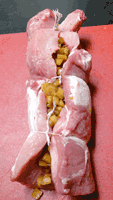WEEK #13 CULINARY CLASS:
In preparation for Thanksgiving our culinary class made turkey 3 ways--stuffed with aromatics and roasted whole on a bed of mirepoix, restaurant-style--butchered, seared and roasted on mirepoix, and deep-fried. And of course, the fixin's: a mashed potato-sweet potato mixture, green beans, cranberry sauce, and gravy. No big surprises, since I've been making Thanksgiving dinner for about 30 years. After so much trial and error, I've found the ultimate for perfect roast turkey: buy an organic, free-range bird that hasn't been frozen, brine it overnight, coat it liberally with paprika, roast with a buttered cheesecloth over the breast for the first hour, baste liberally during cooking, let it sit 20 minutes before carving--it's always moist and tender. (see recipe) But, this year, we're having something different: pork loin stuffed with apples and walnuts and deboned turkey leg stuffed with cranberries and wild rice. The latter I learned in class this week--how to debone the leg, roll it and tie it (same trussing technique as the pork loin). Video one below shows Chef Charles Fredericks butchering a turkey, video two demonstrates how to truss meat.
In preparation for Thanksgiving our culinary class made turkey 3 ways--stuffed with aromatics and roasted whole on a bed of mirepoix, restaurant-style--butchered, seared and roasted on mirepoix, and deep-fried. And of course, the fixin's: a mashed potato-sweet potato mixture, green beans, cranberry sauce, and gravy. No big surprises, since I've been making Thanksgiving dinner for about 30 years. After so much trial and error, I've found the ultimate for perfect roast turkey: buy an organic, free-range bird that hasn't been frozen, brine it overnight, coat it liberally with paprika, roast with a buttered cheesecloth over the breast for the first hour, baste liberally during cooking, let it sit 20 minutes before carving--it's always moist and tender. (see recipe) But, this year, we're having something different: pork loin stuffed with apples and walnuts and deboned turkey leg stuffed with cranberries and wild rice. The latter I learned in class this week--how to debone the leg, roll it and tie it (same trussing technique as the pork loin). Video one below shows Chef Charles Fredericks butchering a turkey, video two demonstrates how to truss meat.
Roast Pork Loin Stuffed With Apples and Walnuts:
2 1/2 lb. boneless center cut pork loin roast, butterflied
salt and fresh ground black pepper
3 Tbsp. olive oil
3 shallots, peeled and minced
2 Tbsp. minced garlic
2 Granny Smith or Pippin apples, peeled, cored and chopped
2 tsp. minced fresh rosemary plus several sprigs
4 Tbsp. brown sugar
1/2 cup toasted walnut pieces
5 cups mirepoix: a mixture of onion, carrot and celery chopped into uniform size, in the ratio of 2 parts onion to 1 part carrot and 1 part celery
8 oz. chicken broth
1/2 cup red wine--some of the Syrah you will pair with the dish will work well
Toast the walnut pieces under the broiler. Remove and let cool. Preheat the oven to 350 degrees. In a large skillet, cook the shallots and garlic in oil until the onion is translucent--do not brown. Add the apples, minced rosemary, and brown sugar and cook until the apples start to soften. Adjust seasonings, if needed. Set aside to cool, then stir in the walnuts.
Have your butcher butterfly the roast or do it yourself by slicing through it lengthwise partway--leaving 1 1/2" intact so you can open it up like a book. Put the roast on plastic wrap and cover with a sheet of plastic wrap. Pound the meat with a meat tenderizer until is is flat. Remove from the wrap and salt and pepper both sides. Run the stuffing in a line down the middle and roll up. Use cooking twine to tie it up in three places, then truss it securely (see video). Put the mirepoix in a deep roasting pan, put the roast on top, arrange sprigs of rosemary around the roast and add the chicken broth. Roast in the oven about 1 hour, until internal meat temperature is 135 degrees, basting with the broth in the pan a few times during the cooking process. Remove roast, tent with foil to keep warm as you make your pan sauce reduction.
Strain the broth and put into a saucepan. Add the wine and cook over high heat until reduced by half. Season to taste with salt and pepper. Remove the twine that trussed the roast, slice into 1 1/2" pieces and drizzle with sauce. Enjoy with a glass of the handcrafted 2008 Jason-Stephens Estate Syrah.
2 1/2 lb. boneless center cut pork loin roast, butterflied
salt and fresh ground black pepper
3 Tbsp. olive oil
3 shallots, peeled and minced
2 Tbsp. minced garlic
2 Granny Smith or Pippin apples, peeled, cored and chopped
2 tsp. minced fresh rosemary plus several sprigs
4 Tbsp. brown sugar
1/2 cup toasted walnut pieces
5 cups mirepoix: a mixture of onion, carrot and celery chopped into uniform size, in the ratio of 2 parts onion to 1 part carrot and 1 part celery
8 oz. chicken broth
1/2 cup red wine--some of the Syrah you will pair with the dish will work well
Toast the walnut pieces under the broiler. Remove and let cool. Preheat the oven to 350 degrees. In a large skillet, cook the shallots and garlic in oil until the onion is translucent--do not brown. Add the apples, minced rosemary, and brown sugar and cook until the apples start to soften. Adjust seasonings, if needed. Set aside to cool, then stir in the walnuts.
 |
| Tie Before Trussing |
Strain the broth and put into a saucepan. Add the wine and cook over high heat until reduced by half. Season to taste with salt and pepper. Remove the twine that trussed the roast, slice into 1 1/2" pieces and drizzle with sauce. Enjoy with a glass of the handcrafted 2008 Jason-Stephens Estate Syrah.













